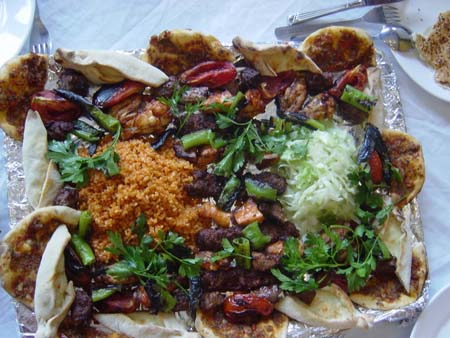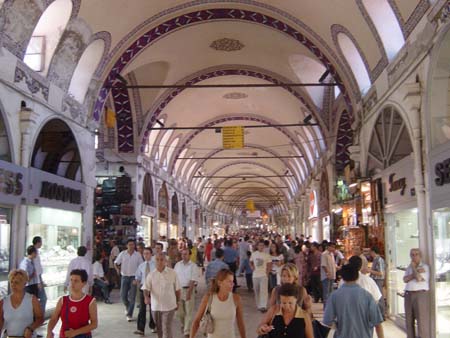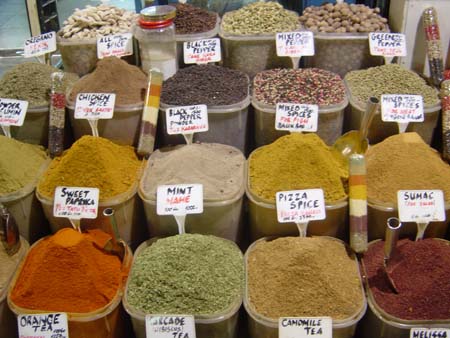Monday, August 25
Paula: Our morning began with a Turkish breakfast. This was different from any of our breakfasts so far - in addition to breads, eggs, juice and tea; we found olives, feta cheese and fresh vegetables. The olives were the best we have ever tasted.
We then met Ali, our guide for the day, and headed into the Old City of Istanbul.
We started at the Hippodrome. We had walked through this area last night and
assumed it was a square or park. Today we learned that it was originally an
area where chariot races were held, and has had important political and social
significance for over 1,400 years. Three monuments stand in the area, the
most amazing being a large Egyptian Obelisk (granite pillar) with hieroglyphics
from 1450 B.C. The Obelisk was brought here in 390 AD by Constantinople and
it took 200 years for the Romans to figure out how to get it upright.
We had never been to a mosque before and found the Blue Mosque to be very
beautiful. Although enormous inside, the round domed ceiling, blue tiles and
stained glass windows make it feel intimate and peaceful. The floor is covered
with a large Turkish carpet with individual prayer areas delineated by the
carpet designs and all facing toward Mecca. It was interesting to hear how
the courtyard of the mosque was also used in earlier days to provide social
services for the community.
The Islam customs are clearly reflected in the daily lives of the people
here. Chants calling for Muslims to pray can be heard throughout the city
as they are broadcasted on large speakers. There are mosques everywhere. A
mosque was even built next to the Grand Bazaar for the 8,000 Bazaar's workers.
Ali the explained several of the Muslim customs to us, and we often saw people
observing these on our walks. He also told us that while many younger Muslims
don't observe prayers five times a day, everyone attends services on Friday
and carefully follow the fasting schedule for Ramadan. It is dishonorable
to miss the weekly Friday service and, according to Muslim law, men who miss
more than three of these services in their lifetime can be denied a proper
funeral. Ali made it clear to us his belief that the Turkish customs and principles
of Islam have grounded the community here, and continue to make Istanbul a
safe, clean and welcoming city.
We briefly visited an underground water system built in 532 AD by the Romans
to bring fresh water (from over 100 miles away) to the city. The 396 Roman
columns were beautiful as they reflected the lit underground pool. We witnessed
an interesting mix of modern and ancient when we found the rehearsal for an
upcoming fashion show taking place in the underground museum. 
We had a wonderful lunch at Buhara 93 Restaurant. There were no tourists
here and Ali knew just what to order so that we could sample some traditional
Turkish cuisine. We feasted on lavage (bread), ayran (salted yogurt drink),
a variety of kabobs and rice. We also enjoyed conversation-Ali was interested
in our trip and is currently getting ready to launch his own tourism business.
He said Turks love to travel and reminded us that "Turks still have their
nomadic roots." We spoke only once of the war in Iraq. Ali's comment
was interesting and probably representative of the opinion of people here.
He stated as a matter of fact, "Everyone knows that the war was all about
oil." Ali also said that there are a much smaller number of  American
tourists in Turkey than there were before the war. We have only seen a few
Americans - most of the foreign tourists seem to be from Italy.
American
tourists in Turkey than there were before the war. We have only seen a few
Americans - most of the foreign tourists seem to be from Italy.
Ali took us to one of the thousands of Turkish carpet stores that are here.
He told us we could receive an "education", even if we had no plans
to buy anything (we didn't!). Once we got started and served drinks by the
owner of the store, we quickly realized that we were in for a pretty high-pressure
sales job. First, the owner explained how the carpets are made and showed
us a variety of rugs including wool, wool on cotton and silk. The hand-knotted
rugs take anywhere from 3-16 months to make depending on size and the number
of knots (sometimes as many as 2,000 knots per inch). The rugs are still made
by skilled women all over Turkey. Ali said every girl learns to make rugs
and that even if they don't make them professionally, women often make rugs
for their children and  homes.
Katie asked whether any men make rugs and Ali laughed saying, "Oh, no
we don't have the patience." It didn't take long before the sales pitch
really got going. The owner had 2 workers literally throwing rug after rug
down on the floor in front of us. The rugs were spun in the air to show off
their colors. By the time it was over, we had probably seen 50 rugs, and the
owner had done his best. To be honest, it was hard to not feel a little guilty
about not making any purchases. The owner indicated that his business is strongly
affected by the economy since his rugs are largely considered a luxury item
and normally bought on impulse. However, we had absolutely no intention of
making a purchase, so we shook hands and departed.
homes.
Katie asked whether any men make rugs and Ali laughed saying, "Oh, no
we don't have the patience." It didn't take long before the sales pitch
really got going. The owner had 2 workers literally throwing rug after rug
down on the floor in front of us. The rugs were spun in the air to show off
their colors. By the time it was over, we had probably seen 50 rugs, and the
owner had done his best. To be honest, it was hard to not feel a little guilty
about not making any purchases. The owner indicated that his business is strongly
affected by the economy since his rugs are largely considered a luxury item
and normally bought on impulse. However, we had absolutely no intention of
making a purchase, so we shook hands and departed.
The Grand Bazaar of Kapali Carsi was next. The bazaar was established in
the 16th century and contains over 4,000 shops. It's an absolutely amazing
place. The bazaar is totally enclosed, and it is hard to believe that this
was constructed for this purpose so long ago. Ali told us that 5,000 customers
visit here every day, and that the bazaar is privately owned. Most of the
shops sell jewelry, gold and silver items for the home, leather and souvenirs.
Bargaining on price is the rule here - Steve and David enjoyed this, but Katie
and I hated it. Katie purchased  several
items but couldn't deal with Steve's insistence on walking away when the price
wasn't right. Her obvious dismay at each of these situations certainly didn't
help our negotiating position! In her mind we were being unkind and even Ali's
explanation of the bargaining culture here could not ease her guilt. Of course,
each of our purchases ended up at 40-50% the original asking price. We thoroughly
enjoyed looking at the huge variety of shops, but have to be careful to limit
the number of things we buy and carry throughout our travels.
several
items but couldn't deal with Steve's insistence on walking away when the price
wasn't right. Her obvious dismay at each of these situations certainly didn't
help our negotiating position! In her mind we were being unkind and even Ali's
explanation of the bargaining culture here could not ease her guilt. Of course,
each of our purchases ended up at 40-50% the original asking price. We thoroughly
enjoyed looking at the huge variety of shops, but have to be careful to limit
the number of things we buy and carry throughout our travels. 
The Spice Market was even more fun. It also dates back to the 16th Century.
Large sacks and containers of colorful spices as well as Turkish candies and
produce lined the rows. We enjoyed snacking on one traditional Turkish treat
with a gummy exterior rolled around walnuts. Ali told us that the spices were
used in food, teas, to dye hair and for health remedies. The market was very
crowded and Ali said that many residents of Istanbul shop here several times
a week. 
Our first full day here was quite colorful and memorable. It was wonderful
to be in a place with so much historical importance. Istanbul was established
in 600 BC as Byzantium by the Greeks. It became the Roman capital in 300 AD.
Christianity was established here during the reign of Roman Emperor Constantine
and the city's name was changed to Constantinople. In the 14th century, the
Ottoman Empire brought Islam, rulers called sultans and another new name,
Istanbul. The last sultan relinquished power in 1923 and the modern republic
of Turkey was established. 
Tomorrow we're spending the day with Talya, who we contacted through Jennifer Coveny at TravelingEd. Talya lives in Turkey, and we're looking forward to learning more about the life and history of the country.
Distance Walked: 2.34 miles


